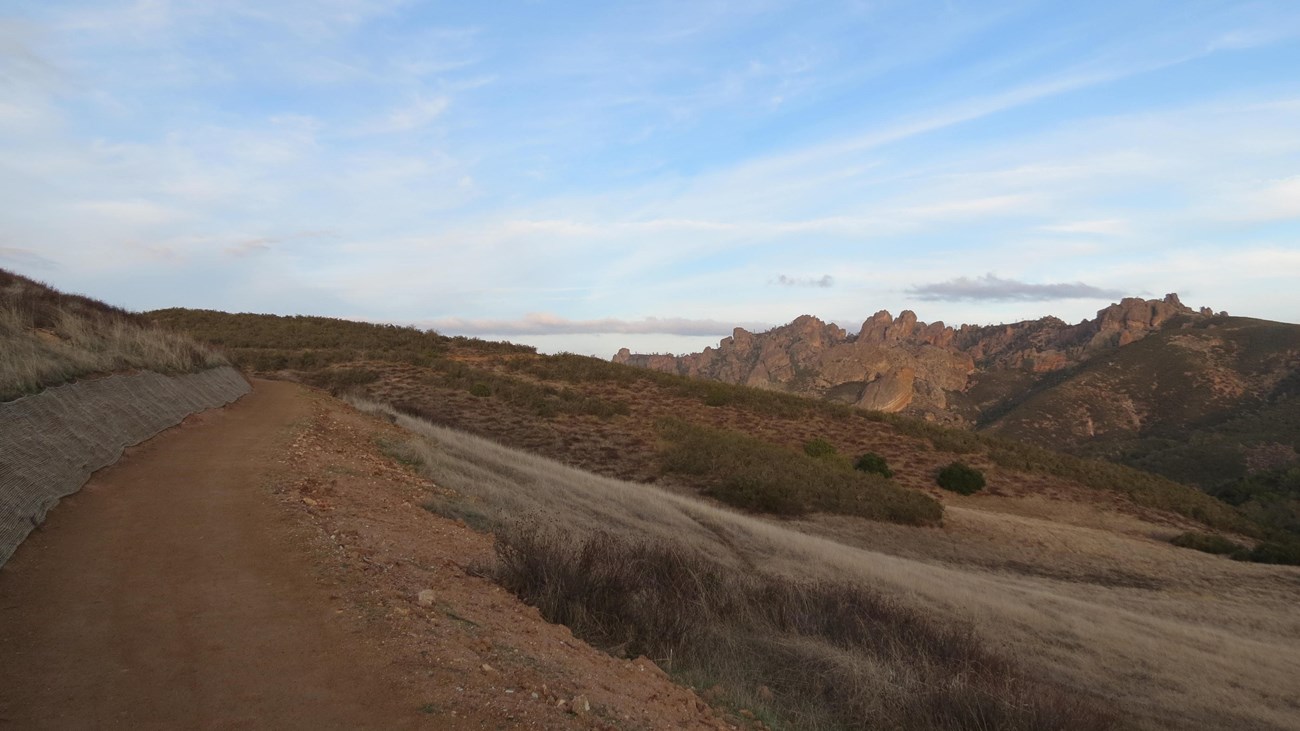Last updated: August 1, 2024
Thing to Do
Hike Prewett Point Trail

NPS Photo/Emily Novack
A gentle hike with great views of the Pinnacles rock formations and the Hain Wilderness to the largest overlook. Some pullouts have benches. There is little shade, and the sun can be intense in the late morning and afternoon.
Recreate Responsibly. Check park webpage alerts and weather forecast. Hiking, caving, and climbing can be fun but remember-if you get injured, you are a long way from medical help. Cell phones may not work in this remote park. Don't let your guard down when it comes to safety. Be prepared. Let someone know your plan before you go. Most of the trails are exposed. Bring a map and use the best judgement of your abilities. Drinking water is only available in developed areas-there is no water along any of the trails. Carry at least a liter of water for every hour of hiking. In winter, wear warm clothes and waterproof clothing. In summer, do not hike during the hottest parts of the day (10AM-4PM) especially on strenuous trails. Heat and dehydration can be fatal. Hiking steep trails requires more energy and results in greater water loss through sweating. Wear lightweight, light-colored, loose-fitting clothing. Wear sunscreen, a hat, and sunglasses. Wear sturdy, non-slip shoes or boots with ankle support due to rocky, uneven terrain and slick and sometimes slippery rocks. In all seasons, carry plenty of water and salty snacks (ex. pretzels, crackers, chips). Stay hydrated with plain water and an electrolyte drink replacement. Stay cool in summer and warm in winter and take rest breaks. Know your limits and turn back if needed. Stay on established trails to help prevent erosion. Wildflowers, pine cones, rocks, and other natural and cultural features are beautiful, but please do not remove or destroy them;leave them for the enjoyment of other visitors. All plants, animals, rocks, and structures in the park are protected by federal law. Be careful where you sit, step, and place your hands: poison oak, stinging nettle, and rattlesnakes are found here. Feeding, approaching, or hunting wildlife is prohibited. Using remotely piloted aircrafts like drones is prohibited.
Plan ahead and prepare. Take only pictures and leave only footprints, leaving objects as you find them. Observe wildlife from a distance and avoid loud voices or noises to be considerate of others.
Recreate Responsibly. Check park webpage alerts and weather forecast. Hiking, caving, and climbing can be fun but remember-if you get injured, you are a long way from medical help. Cell phones may not work in this remote park. Don't let your guard down when it comes to safety. Be prepared. Let someone know your plan before you go. Most of the trails are exposed. Bring a map and use the best judgement of your abilities. Drinking water is only available in developed areas-there is no water along any of the trails. Carry at least a liter of water for every hour of hiking. In winter, wear warm clothes and waterproof clothing. In summer, do not hike during the hottest parts of the day (10AM-4PM) especially on strenuous trails. Heat and dehydration can be fatal. Hiking steep trails requires more energy and results in greater water loss through sweating. Wear lightweight, light-colored, loose-fitting clothing. Wear sunscreen, a hat, and sunglasses. Wear sturdy, non-slip shoes or boots with ankle support due to rocky, uneven terrain and slick and sometimes slippery rocks. In all seasons, carry plenty of water and salty snacks (ex. pretzels, crackers, chips). Stay hydrated with plain water and an electrolyte drink replacement. Stay cool in summer and warm in winter and take rest breaks. Know your limits and turn back if needed. Stay on established trails to help prevent erosion. Wildflowers, pine cones, rocks, and other natural and cultural features are beautiful, but please do not remove or destroy them;leave them for the enjoyment of other visitors. All plants, animals, rocks, and structures in the park are protected by federal law. Be careful where you sit, step, and place your hands: poison oak, stinging nettle, and rattlesnakes are found here. Feeding, approaching, or hunting wildlife is prohibited. Using remotely piloted aircrafts like drones is prohibited.
Plan ahead and prepare. Take only pictures and leave only footprints, leaving objects as you find them. Observe wildlife from a distance and avoid loud voices or noises to be considerate of others.
Details
Duration
30-60 Minutes
Activity
Hiking
Accesible trail
Age(s)
All ages, but minors must be with an adult parent or guardian.
Pets Allowed
No
Activity Fee
No
No additional fee to hike but there is a park entrance fee. Learn more about Fees and Passes.
Location
West Visitor Contact Station Parking Area
Enter west side of the park from HWY 101 and Metz Road to HWY 146/Chaparral Road. Trailhead starts from West Visitor Contact Station.
Reservations
No
Season
Year Round
Time of Day
Any Time
Accessibility Information
Difficulty: Easy
Distance: Approx. 0.9 miles round trip
Trail width: Approx. 3 - 5 feet
Maximum grade: 70 feet
Surface Composition: dirt
Exposure: No shade
*Accessible for wheelchairs and mobility devices
*Service animals permitted
Distance: Approx. 0.9 miles round trip
Trail width: Approx. 3 - 5 feet
Maximum grade: 70 feet
Surface Composition: dirt
Exposure: No shade
*Accessible for wheelchairs and mobility devices
*Service animals permitted
